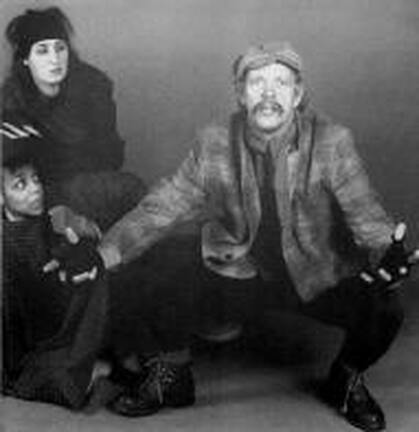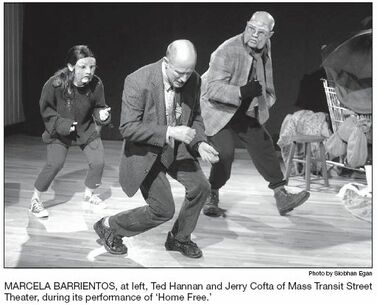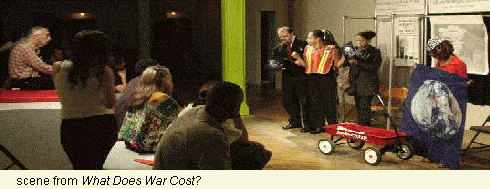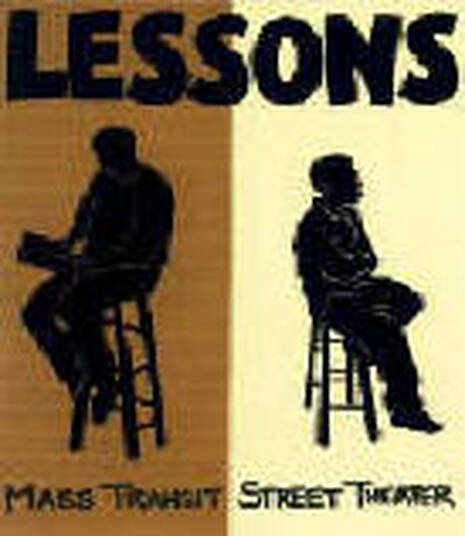|
For 51 years, since the first Earth Day in April 1970, Mass Transit has been bringing people together to enjoy a play, a workshop or screening, then promoting discussions and interactive experiences to apply our insights to our intentions and actions. This is the role we have played for decades. Our work continues to be enjoyed by hundreds of students, educators and community members each year, and generously supported by the New York State Council on the Arts, Bronx Council on the Arts, The NYC Department of Cultural Affairs, and The New Yankee Stadium Community Benefit Fund. |
|
Before 1973, when abortion was still illegal, members of Mass Transit Street Theater gathered near a Bronx church to perform a piece about a woman’s right to choose. In the audience watching the show were several Roman Catholics who stayed to have a thoughtful conversation with the actors about the controversial topic. “There’s something about theater,” said Jerry Cofta, co-founder of the Bronx-based community theater group, which is celebrating its 50th anniversary next year. “It allows people to talk because we don’t throw these subjects into people’s faces in an antagonistic way — the plays are usually entertaining, often funny.”
|
Since its inception in 1970, Mass Transit has used song, storytelling and dance to create progressive, socially-conscious works. Over the years, the troupe has tackled issues such as war, racial equity, feminism, education and housing. Mass Transit outlived similar performance groups scattered throughout the borough in the 1970s. The troupe moved from parks and street corners into community centers and theaters and, more recently, has incorporated video in its performances. For its 35th anniversary, Mass Transit revived Home Free, a 15-year-old production it considers a landmark. Mr. Cofta did little rewriting to bring the play up to date. Set on a platform in the lower reaches of Grand Central Terminal, Home Free addresses the elusiveness of the American dream. A man undergoing a mid-life crisis — disillusioned and yearning for a simpler time — spends a night in the company of three homeless people. “The homeless issue and the protagonist’s search for meaning are still relevant,” Mr. Cofta said. The play, which had its final performance on Saturday, got people talking on June 3 at the Puffin Room in Manhattan. As always, Mr. Cofta invited the audience to share their thoughts after the show. “Our plays really grow out of stories people tell us after the performances and in interviews,” said Lyn Pyle, the troupe’s co-founder, former Director and a well-known community activist in nearby Norwood, who has been a leading opponent of building the water filtration plant in Van Cortlandt Park.
For decades, Mass Transit has been using video, sometimes in conjunction with live performance. Co-founder Lyn Pyle called her adoption of multi-media performance an “accident,” explaining that she offered to carry the video camera while attending the Fourth World Conference on Women in 1995 in China. “I knew nothing about video, but I came back with 18 hours of incredible footage of women from all over the world,” she said. “So I had to learn how to make a video.” Ms. Pyle transformed the footage into We Are the Leaders, which sold about 300 copies. She’s been hooked on video ever since and changed the group’s name to Mass Transit Street Theater & Video. Her 2003 work, What Does War Cost the Bronx?, examines a woman who is torn because she wants to support a son who is serving in Iraq, but who believes the administration lied to justify sending the troops in. “We’re taking a contemporary situation and exploring it from all the different points of view from the people involved,” Ms. Pyle said. She continued working in this vein on her next film, about the daily violence Bronx teenagers experience. Mr. Cofta who is currently MT's Board Treasurer is not concerned about Mass Transit’s future. “There’s been a rebirth of interest by much younger people in this type of theater,” he said.
For decades, Mass Transit has been using video, sometimes in conjunction with live performance. Co-founder Lyn Pyle called her adoption of multi-media performance an “accident,” explaining that she offered to carry the video camera while attending the Fourth World Conference on Women in 1995 in China. “I knew nothing about video, but I came back with 18 hours of incredible footage of women from all over the world,” she said. “So I had to learn how to make a video.” Ms. Pyle transformed the footage into We Are the Leaders, which sold about 300 copies. She’s been hooked on video ever since and changed the group’s name to Mass Transit Street Theater & Video. Her 2003 work, What Does War Cost the Bronx?, examines a woman who is torn because she wants to support a son who is serving in Iraq, but who believes the administration lied to justify sending the troops in. “We’re taking a contemporary situation and exploring it from all the different points of view from the people involved,” Ms. Pyle said. She continued working in this vein on her next film, about the daily violence Bronx teenagers experience. Mr. Cofta who is currently MT's Board Treasurer is not concerned about Mass Transit’s future. “There’s been a rebirth of interest by much younger people in this type of theater,” he said.
In a brighty-lit car of the # 4 train, as they return to the Bronx from work, John & Yvette meet a homeless Aunt Sam (recently kicked out of government in Washington) and the Truth Fairy who strangely enough changes subway ads for the MTA. At the heart of the play is Yvette's struggle to support her soldier son and face the truth of a war that puts his life at risk. The encounter of the four characters is heated and generates many questions for the audience discussion that follows each performance. What is patriotism? Who's telling the truth? What is the impact of war on the people and things we care about in New York City -- like our schools, health care, and the security of our families and communities? And what do we truly value in our relationships with one another and with others in our global village?
|
LESSONS explored central conflicts in today’s society through the prism of a South Bronx classroom. Jerry Cofta (writer and actor) and Ted Hannan director, have spent much of their careers with a dual focus -- theater and education. Jerry is a language arts teacher in a South Bronx alternative high school and Ted is a professor at the Tisch School of Arts, NYU. They begin this new theatrical piece using their shared knowledge from their hands on work within the field of Education.
It is their expectation that much of what we are about as a society, our dreams, our disappointments, our anger and our fears, will be revealed in a playing out of how we learned – then and now. Lessons, set in an urban high school, presents a teacher and a student, ( played by Russell G. Jones, an Obie and SAG award winning actor), old and young, white and black, locked (metaphorically) in a classroom, each wanting to get out, each desperately needing to stay. The play, through the prism of education continues our exploration with our audience of where we have been, of our commonalties and differences, and where we need to go, as a community. |




